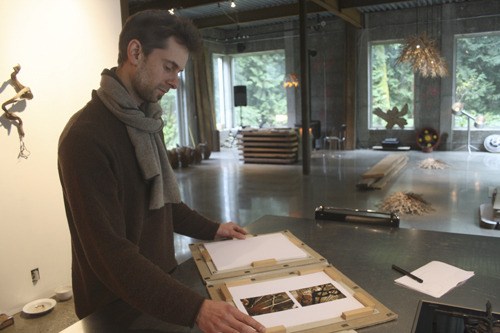Winter Studio Tour
Winter Studio Tour: The 28th annual Winter Studio Tour is from 10 a.m.-6 p.m. Dec. 2-4 at 10 studios and community halls throughout Bainbridge Island.
The free, self-guided tour features the work of 70 artists and can be accessed by car or bike.
Robert Spangler Studio
Perhacs Studio
American Legion Hall
Filipino-American Hall
Bainbridge Commons
Grange Hall
Siebert Pottery Studio
Mesolini Glass Studio
Hidden Cove Pottery
Seabold Hall
Directions and a map are available at www.bistudiotour.com.
Art, essentially, is born of a series of choices: medium, palette, realism or abstraction, line and form and combinations thereof, interplay of light and dark, texture, and opaqueness of meaning. Each choice disallows all other possibilities, and eventually a work expresses the aggregate of an artist’s preferences at that given time.
To commit to each choice and forgo the alternatives takes courage. The most original and inventive work, that which veers dramatically from the collective norms, carries the risk of ridicule and rejection, not to mention a lack of commercial viability. And yet, it is at this periphery where inspiration dwells.
Likewise, being an artist requires an ongoing series of choices, each which sets the artist on a new trajectory. Each requiring its own measure of courage.
For Bainbridge artist Brandon Perhacs, a pivotal decision came early on at the Art Center College of Design in Pasadena, Calif. After the euphoria of a generous scholarship to the prestigious art school, Perhacs sensed that the school’s emphasis on product over process didn’t resonate with his own values about art making.
“It’s one of the best schools, but they turn out people to turn out things for production,” he said Monday at the home|studio space where he lives|works on the island.
“I’m much more interested in the physical poetry of things. I hesitate to say spiritual, but the poetic,” he said.
By this time he’d made other choices: three-dimensional design, contemporary aesthetic, Eastern principles, organic forms, natural materials. He also chose to return to the Northwest, working out of a studio space in Pioneer Square.
When the contemporary space he built with his mother, Bainbridge artist Katherine Michaels, became available, he came full circle back to the island.
A year and a half ago, he opened the expansive, minimalist space he dubbed studio(p) for salon-style gatherings among island artists.
“My intention was to make this a community incubator,” he said. “I am interested in creating an environment that nurtures art and community.”
His last salon drew “70 or so people,” but he realized the effort to host them put his own work on the backburner.
And there’s the Catch-22 every artist deals with: making a living.
“It’s hard to balance those two things. You either need a regular job and do the art on the side, or you need to find a way to make money with your art,” he said.
He turned his focus on developing his line of lighting, home decor and jewelry, exhibiting in a juried show at the Chelsea Art Museum in New York City in May. He signed up for the studio tour. He said he’ll resume the salon gatherings next year.
“I think that art and aesthetics are an important part of life,” Perhacs said. “Some people think the arts are not important, but if you take that away, it is a horrible state to be in. Art makes life worth it.”
Perhacs, the son of artists and grandson of an inventor, thinks art is in his genes.
“I get more satisfaction from someone having an amazing experience around art, than making a sale. And yet…you have to pay the bills. It’s a really tough balance.”
With every choice he makes or doesn’t, he “sculpts” his version of the creative life.
• • •
Perhac’s mother has made her own choices, walking that fine line between art and the business of living. Once a successful carver and sculptor, the toxic chemicals of the foundry she co-owned forced her to abandon her first love.
Slowly she is “forging” a new body of work: bowls made of paper handmade by women in Zimbabwe. Michaels repulps the material, mixing and adding organic components – seedpods, blossoms, rocks, plant fibers – mixing in bee’s wax to harden the forms.
“It’s a feminine thing, the concept of doing vessels,” she said in her upstairs studio at her home on the south end of the island.
“They are meant to hold things, hold spirit,” she said. “It’s the feminine concept of holding.”
She experienced a time of gestation around this new work, which she has only shown at Island Gallery, so far.
To balance the bills and artmaking, Michaels makes documentary videos with her husband, Alan Honnick. One she is particularly proud of is “The Art of Lost Wax Casting” about an old-school method for casting sculpture.
• • •
Mother and son respect each others aesthetic and seek the other’s input on their individual work. They have collaborated on many creative projects, including the space that is now Perhacs Studio. Both will show their respective work there as part of this year’s Bainbridge Island Winter Studio Tour.



